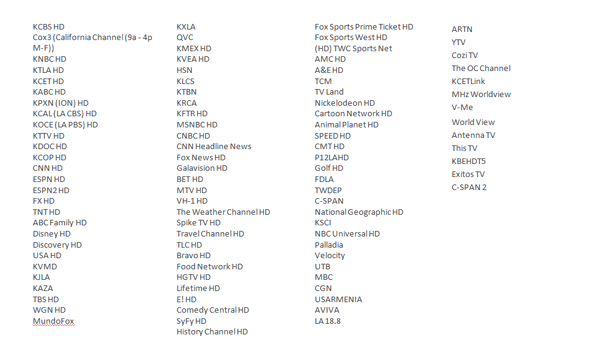 CBS has blocked Time Warner Cable and Bright House Networks’ broadband customers from watching CBS online video in a retaliatory move against Time Warner Cable’s decision to pull CBS-owned programming off the lineup because of a contract dispute.
CBS has blocked Time Warner Cable and Bright House Networks’ broadband customers from watching CBS online video in a retaliatory move against Time Warner Cable’s decision to pull CBS-owned programming off the lineup because of a contract dispute.
Broadband customers of both cable companies (Bright House relies on Time Warner Cable to negotiate its programming carriage agreements) started losing access to CBS streamed content late Friday, now replaced with a message blaming Time Warner Cable for the loss. Earthlink customers using either cable operator are collateral damage — Earthlink is effectively reselling the others’ cable broadband services.
“If Time Warner Cable is a customer’s Internet Service Provider, then their access to CBS full episode content via online and mobile platforms has been suspended as a result of Time Warner Cable’s decision to drop CBS and Showtime,” said a CBS spokesperson. “As soon as CBS is restored on cable systems in affected markets, that content will be accessible again.”
In place of the programming, cable customers get to see a brief attack ad criticizing Time Warner for yanking CBS-owned channels and networks, despite the fact CBS authorized the companies to keep the channels up and running until the dispute can be worked out.
Time Warner Cable shot back with their own rebuttal.
[flv width=”640″ height=”380″]http://www.phillipdampier.com/video/CBS Blackout – We Dont Want a War 8-4-13.flv[/flv]
Time Warner Cable claims it does not want a war over programming costs in its latest ad regarding the blackout of CBS programming, which now also affects the cable company’s broadband customers. (1 minute)
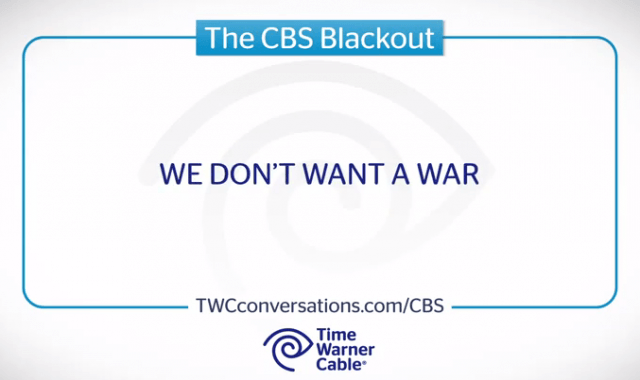 “CBS has shown utter lack of regard for consumers by blocking Time Warner Cable’s customers, including our high-speed data only customers, from accessing their shows on their free website,” the company said in a statement. “CBS enjoys the privilege of using public owned airwaves to deliver their programming – they should not be allowed to abuse that privilege.”
“CBS has shown utter lack of regard for consumers by blocking Time Warner Cable’s customers, including our high-speed data only customers, from accessing their shows on their free website,” the company said in a statement. “CBS enjoys the privilege of using public owned airwaves to deliver their programming – they should not be allowed to abuse that privilege.”
Customers well outside New York, Dallas, and Los Angeles discovered several CBS-owned cable channels were missing, even though they are not served by a CBS-owned local affiliate. The most obvious — Showtime/The Movie Channel came during the middle of the latest season of Dexter.
New York City residents can sat least keep watching WCBS by signing up for Aereo, which streams local stations over the Internet. A 30-day free trial is available. Getting programming in other cities is going to be much tougher. Some predict hardcore viewers will just look for pirated copies of their favorite shows.
CBS said no further negotiation took place over the weekend. Some industry analysts predict the impasse could run for weeks, even potentially until the start of football season — considered a line of PR destruction neither company is willing to cross.
Golf is not as critical, apparently. The PGA Championship taking place in Rochester, N.Y., this weekend is likely going to get a smaller viewing audience because of the blocked programming.
[flv width=”640″ height=”380″]http://www.phillipdampier.com/video/Bloomberg CBS Blackout Enters Third Day 8-5-13.flv[/flv]
The blackout of CBS programming by Time Warner Cable enters its third day with no light at the end of the tunnel, suggests this Bloomberg News report. (3 minutes)
[flv width=”640″ height=”380″]http://www.phillipdampier.com/video/Bloomberg Day Three of CBS Blackout Angers Audiences 8-5-13.flv[/flv]
This is not the first time broadcasters and cable operators have cut viewers off, sometimes for more than a week. Bloomberg News reports the soft deadline for Time Warner and CBS to sort out their differences is the start of the fall football season. Sources say Time Warner now pays $1 a month for CBS, but the network now wants $2 a month. (3 minutes)


 Subscribe
Subscribe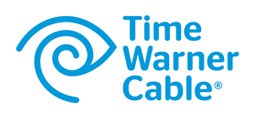 Time Warner Cable admitted this morning extracting more revenue from existing customers was more important than attracting new ones, and long time subscribers responded by canceling service in above average numbers.
Time Warner Cable admitted this morning extracting more revenue from existing customers was more important than attracting new ones, and long time subscribers responded by canceling service in above average numbers.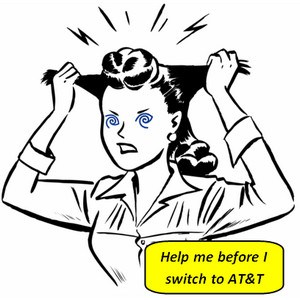

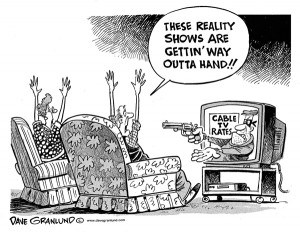 Although cable and phone companies love to declare themselves part of a fiercely competitive telecommunications marketplace, it is increasingly clear that is more fairy tale than reality, with each staking out their respective market niches to live financially comfortable ever-after.
Although cable and phone companies love to declare themselves part of a fiercely competitive telecommunications marketplace, it is increasingly clear that is more fairy tale than reality, with each staking out their respective market niches to live financially comfortable ever-after. That means Time Warner Cable has an 80 percent market share. Actually, it is probably higher because that total number of households includes those who either don’t want, need, or can’t afford broadband service. Some may also rely on limited wireless broadband services from Clearwire or one of the large cell phone companies.
That means Time Warner Cable has an 80 percent market share. Actually, it is probably higher because that total number of households includes those who either don’t want, need, or can’t afford broadband service. Some may also rely on limited wireless broadband services from Clearwire or one of the large cell phone companies. Rochester remains a happy hunting ground for Internet Overcharging schemes because the only practical, alternative broadband supplier is Frontier Communications, which Time Warner Cable these days dismisses as an afterthought (remember that 80 percent market share). Without a strong competitor, Time Warner has no problem experimenting with new “usage”-priced tiers.
Rochester remains a happy hunting ground for Internet Overcharging schemes because the only practical, alternative broadband supplier is Frontier Communications, which Time Warner Cable these days dismisses as an afterthought (remember that 80 percent market share). Without a strong competitor, Time Warner has no problem experimenting with new “usage”-priced tiers.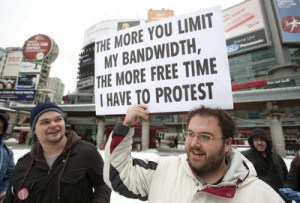 In nearby Ohio, the average broadband user already exceeds Time Warner’s 30GB pittance allowance, using 52GB a month. Under both plans, customers who exceed their allowance are charged $1 per GB, with overlimit fees currently not to exceed $25 per month. That 30GB plan would end up costing customers an extra $22 a month above the regular, unlimited plan. So much for the $5 savings.
In nearby Ohio, the average broadband user already exceeds Time Warner’s 30GB pittance allowance, using 52GB a month. Under both plans, customers who exceed their allowance are charged $1 per GB, with overlimit fees currently not to exceed $25 per month. That 30GB plan would end up costing customers an extra $22 a month above the regular, unlimited plan. So much for the $5 savings.
 Cox Communications has found a new way to target cord-cutters and sell television service to its broadband-only customers reluctant to sign up for traditional cable television.
Cox Communications has found a new way to target cord-cutters and sell television service to its broadband-only customers reluctant to sign up for traditional cable television.